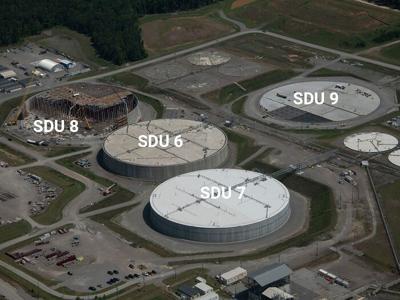More gaps have been discovered in the Savannah River Site 's saltstone disposal units. Operators using cameras discovered gaps in the gaskets where the roofs and walls of SDUs 7 and 8 meet, Defense Nuclear Facilities Safety Board inspectors reported March 14 . The Defense Nuclear Facilities Safety Board is an independent federal agency that oversees the Department of Energy's work to produce materials for Department of Defense and to clean up Cold War-era nuclear waste.
"...

it was later discovered through camera footage that there are gaps through the gasket in SDU 7 and 8 as well, albeit smaller than in SDU 6," the inspectors wrote. The discoveries were made one month after Savannah River Mission Completion personnel discovered a gap in the gasket of SDU 6 . SRMC is the liquid waste contractor at the Savannah River Site.
SRMC engineers performed a settlement analysis on SDU 6, which showed very little settling, the inspectors continued. "They are evaluating material condition and will determine what repairs will need to be made going forward," the inspectors said. "Saltstone personnel plan to process radioactive waste in SDU 7 with the small gaps and plan on revising the SDU 7 operations procedures to require exhaust ventilation while operating to provide additional protection.
" Air samplers have been placed around the SDUs and radiological surveying has been increased. The three SDUs are the first mega-units — they hold up to 33 million gallons — built at the site. SDU 6 was completed in May 2017 and began receiving saltstone in August 2018.
SDU 7 was completed in July 2021 and SDU 8 was competed in 2023. SDUs are one of the endpoints of the effort to dispose of nuclear waste generated at the site during the Cold War. The Cold War nuclear waste is divided into two types: salt and sludge.
The sludge makes up around 8 percent of the volume of the tank but nearly half of the radioactivity. The salt makes up around 92 percent of the volume and just over 50 percent of the radioactivity. The sludge goes to the Defense Waste Processing Facility and is ultimately vitrified — converted into a glass-like substance — and placed in storage containers to await the construction of a permanent national nuclear waste repository.
The salt goes to the Salt Waste Processing Facility. The facility extracts high-level waste and sends it to the Defense Waste Processing Facility. The remaining waste, called decontaminated solution, is sent to the Saltstone Production Facility.
The solution is converted into a concrete-like substance and placed in one of 12 SDUs ..
Technology

More gaps discovered in Savannah River Site saltstone disposal units

More gaps have been discovered in the Savannah River Site's saltstone disposal units.















